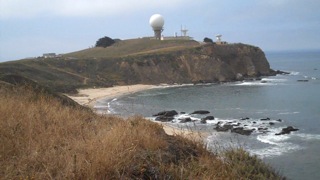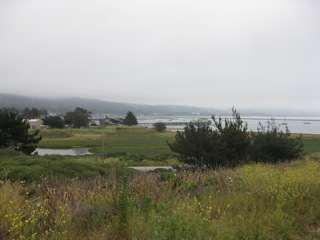Meet author Rob Tillitz at Harbor Village Books on Saturday, July 18. His new book is called: “Bootlegger’s Cove,” a true story that takes place on our own South Coast.
Image Below: “Thoughtful Rob”
[Part of a story by Rob Tillitz]
Rob Tillitz
7784 Palmyra Drive
Fair Oaks, CA 95628
916-965-9510
e-Mail: [email protected]
© 2008
By Rob Tillitz
First Serial Rights
Approx. 5,250 Words
BEAUTY SECRET
By Rob Tillitz
On the cold Pacific, on the border with Oregon and in the northwest corner of California, is the casual country-town of Crescent City. “Where the Redwoods Meet the Sea” is the town slogan. Well, that, and “Comeback Town — U.S.A.” as it was called after the ‘64 tidal wave that inundated the wee population of only several thousand.
Andriana Walton, with only six months as a teenager behind her, lived in one corner of the sprawled-out settlement, close to the middle and high schools, and not far from the rocky shoreline along Pebble Beach Drive where she sometimes went to study marine life in the tide pools.
Attractive and athletic, the sandy-haired cheerleader was well situated, however unhappy today about her mildly pudgy visage.
“I might be a teenager now, but I still look like a chubby-faced twelve-year-old,” she sighed into her dressing table mirror.
Her face was a perfect oval with golden hair pulled back tight in a ponytail. She had warm blue eyes, a squared jaw, and a sprinkling of freckles. Today’s wardrobe was black jeans, a frilled pink T-Shirt that said “IF THE PHONE DOESN’T RING, IT’S ME,” and pink on white gym shoes. She might have been any other eighth-grader except there was a serious sadness cast about her eyes. She looked like a girl that had to grow up too soon.
“Andi” got up and walked away from the mirror, plopped into a stuffed chair, and began to flip through a supermarket scandal sheet. She stopped at an article about some miracle plant: “It will dissolve the baby fat in a young teen’s face and leave a girl looking lean and mature with radiant skin,” the article boasted.
The plant was actually a fungus, and was from the coastal mountains of northwest California. “Grows only on a strain of hybrid, second-growth redwood,” she read, realizing that would be only in the Crescent City area. Her area!
“In the early days of reforesting, about 1960, after clear-cutting the giant old redwoods,” the article explained, “hybrid saplings, laboratory engineered, were planted with the expectation they’d grow to old-growth giant-size within a short hundred-year cycle, a remarkably quicker maturity rate over the old giants that took 1,000’s of years to grow.” She was reading out loud now: “Perfect Profile. Put on this facial mask and it will draw out all your excess toxins and fat, leaving your skin luxurious and perfect…” her voice perked and hit several notes when she said “perfect.” But then: “To order, you must send $99 and allow six to eight weeks for delivery.” She stared out the window at the big old willow tree. “I don’t want to spend $99 of my baby sitting money, and I don’t want to wait two months to become beautiful,” she said to the sparrows that flitted in the grass under the willow tree.
The phone rang. “I’m here,” Andriana answered, somewhat listless, but slightly disturbed.
“You don’t sound too good,” her best friend Letty said. Letty was fifteen. She had a seventeen-year-old boyfriend, but still spent equal time with Andriana. Delbert, her boyfriend, had a 4-wheel drive. The three kids often cruised around in that, making sure everything about the city was as it should be.
“Oh, I know. I don’t feel good, and I’m ugly and….”
“You are not!”
“… and I want to go find this plant that grows around here; it’s a fungus that grows on the newer redwood trees. I need to go up to the mountains,” she expounded.
A rain cloud opened up outside and all the sparrows flew away.
“Del can take us up into the mountains,” Letty offered.
“I was wondering, but I didn’t want to ask.” Andriana was buoyed by this.
“But we need gas money. You know, he doesn’t have a job right now….”
“Yeah, I know. Let me call my dad, and then I’ll call you right back. I’ll try to get some money for gas.”
* * *
Gar Walton, Adrianna’s father, knew full well that his daughter was well gifted with the same steering gene that most daughters have. But he sent the money anyway and was tickled by his daughter’s creativity: She was organizing an expedition into the local mountains to find a miracle plant, some sort of beauty secret. He cautioned her to prepare, and prepare well, for the mountains. With warm clothes, a heavy jacket, boots and extra food just in case.
“I’ll send the money right now to Western Union. Have a good adventure,” he said lovingly and rang off.
Andriana called Letty back, absolutely ebullient. “I got gas money waiting at Western Union!”
“Okay, I’ll come over with Delbert. We’ll see you soon.”
———
The Western Union man had warm blue eyes that Andriana was certain she recognized. He was an average looking man, but very tan. And he had a distinctive look about his bald head: at the crown of his oval face, a six-inch tuft of hair was neatly combed back, perhaps as an attempt to cover the character’s pate.
“It’s a bea-u-ti-ful day, how may I help you?” He snapped with polite precision.
“I believe I have money waiting. It’s from Gar Walton to Andriana Walton.”
“Ah yes, little lady. Step right this way….”
* * *
“Where to first?” Delbert asked. He was a stocky, redneck farm boy with real short reddish hair, and not overly talkative. He lived mainly for his girl friend, Letty, and deer hunting. Letty was an older version of Andriana. The two girls were often mistaken for sisters, except Letty didn’t have Andriana’s diplomacy. All three of them wore Levis, sweatshirts, and boots.
Andriana spoke up, “We need to find second-growth redwood trees, some that were planted in the sixties. The fungus we’re looking for is pink and looks like brain coral; it grows on fallen logs,” she spoke to her left across the truck’s bench seat. It was a yellow Toyota 4-Runner. Toby Keith sang in the background.
Delbert bit his lower lip, “Let’s go down to Mill Creek, then up to the old Miller-Rellim property. That’s the closest and easiest place.” Delbert knew his way around.
“Do it, Del.” Letty interjected, as she often did when her boyfriend talked only to Andriana. She could not help being jealous.
“Yes, dear,” he said a bit mocking, and she punched him in the arm. Letty was strong, and Del rubbed his arm, smart not to say anything more.
* * *
They turned off the main highway and immediately came upon three black tail bucks posing in the road. The deer, two three-points and a forked-horn, stared at the kids majestically. But then they slowly tip-toed off the road as if the gravel hurt their feet. It was still weeks until deer season, and the bucks instinctively knew this.
Resuming the drive, they passed through a thin foggy belt of old-growth redwood — the big trees manufacture their own weather and they prefer fog. That lasted for a half-mile before they broke out under a gray sky and were into poplars and brush as the truck motored along parallel to Mill Creek.
Delbert announced, “Just up ahead here is second-growth. ‘Bout what you said you wanted.” They drove a little further, and got back underneath the conifers.
Then Andriana said, “We need to look for fallen logs — that’s where the fungus grows.” She sat forward on the seat, peering out the windshield trying to spot an auspicious log. It was dark and damp under the tall trees, and Del had a country western tape playing real low on the stereo. Letty’s perfume smelled like the flowers in the country song.
The kids wandered along through redwoods at least as tall as two telephone poles; a few as much as five feet across the base. It was mostly sunless under the semi-giant too-close-together hybrid California redwoods. And rafts of fern spread out underneath the trees as the truck wound its way through the forest. An occasional bird jumped out of the brush that grew only along the road, and once they startled a covey of quail that was crossing the well maintained government right-of-way.
The gravel road dipped down into a stream bed lined with red alders, and at the far end of a 100-foot-long bridge, a U.S Forest Service truck was parked.
They crossed over the bridge. Below in the rocky stream bed was a crystal clear flow of beautiful mountain water. It was ten feet across, and the water moved rapidly over gray and white well-rounded rocks, making a sound similar to an applauding crowd. The rocks at the stream’s edge were green with moss. Andriana looked up the creek, where the sun shone a bright yellow and was nestled perfectly within the creek’s valley.
A forest ranger stood next to the truck. He was bald except for a six-inch tuft of brown-gray hair sprouting from his forehead peak and wound carefully back across a tan dome. He wore a well pressed khaki shirt and forest green Lee jeans. The man’s smile was familiar to Andriana, and his eyes were eerily recognizable.
She rolled down her window and a dank, evergreen smell drifted in. It was early September and there was still dust, though a recent drizzle had things a bit soggy.
When Delbert had the Toyota stopped next to him, the ranger greeted the three “hunters” with a quick smile, saying, “It’s a beautiful day, how can I be of assistance?”
The man was on Andriana’s side of the truck so she spoke out her window, “We’re looking for fallen logs…we’re trying to find—”
“Lookin’ for beauty secrets, are ya’s?” The ranger arched an eyebrow — which is a genetic thing that only some people can do — then chuckled.
Andriana blushed, “It’s not polite to ask girls beauty questions:”
“Well, little lady, perhaps you’re right. You’re as pretty as a spring rose already; I don’t know why you’d want to change. But whatever you’re up to, those pink trucks are the Perfect Profile people. Watch out for them! They think they own every piece of that fungus, figure their patent covers these woods, too. But, I’ll tell you what: It doesn’t! But watch them anyway; I don’t trust them people.” And with that the natty ranger shook his head while making a clucking sound. Then he spun around and walked toward his light green truck.
“Let’s go,” Letty said to Delbert. She had her hand on his far shoulder, and brought it up to rub the stubble on an almost-shaved head. Letty liked that, and so did he.
Delbert dropped the 4-Runner into first and let out the clutch. He considered that the Ranger was right: Andriana was gorgeous enough. Though he wouldn’t dare ever say that out loud, least not where Letty could hear. He was also thinking that the ranger’s eyes were exact duplicates of Andriana’s.
Further up the road they came upon a flat area that was fairly clear underneath the somber trees.
“Right here.” Andriana pointed to a turnout in the road.
* * *

